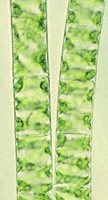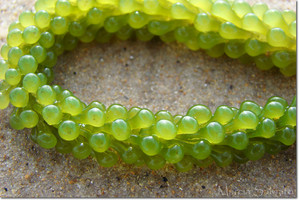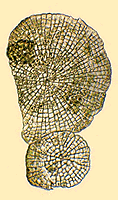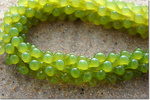Green plants
Richard M. McCourt, R. L. Chapman, Mark Buchheim, and Brent D. Mishler


This tree diagram shows the relationships between several groups of organisms.
The root of the current tree connects the organisms featured in this tree to their containing group and the rest of the Tree of Life. The basal branching point in the tree represents the ancestor of the other groups in the tree. This ancestor diversified over time into several descendent subgroups, which are represented as internal nodes and terminal taxa to the right.

You can click on the root to travel down the Tree of Life all the way to the root of all Life, and you can click on the names of descendent subgroups to travel up the Tree of Life all the way to individual species.
For more information on ToL tree formatting, please see Interpreting the Tree or Classification. To learn more about phylogenetic trees, please visit our Phylogenetic Biology pages.
close boxIntroduction
Green plants as defined here includes a broad assemblage of photosynthetic organisms that all contain chlorophylls a and b, store their photosynthetic products as starch inside the double-membrane-bounded chloroplasts in which it is produced, and have cell walls made of cellulose (Raven et al., 1992). In this group are several thousand species of what are classically considered green algae, plus several hundred thousand land plants.Discussion of Phylogenetic Relationships
There are two major lineages of green plants. One consists of most of what have been classically considered "green algae"--mostly microscopic freshwater forms and large seaweeds. The other lineage contains several groups of "green algae" that are more closely related to land plants. Because these two lineages are monophyletic, they have been placed in a single monophyletic group called green plants, or, in technical parlance, the subkingdom Chlorobionta (Bremer, 1985).The groups of the primary "green algal" lineage included here (Prasinophytes, Chlorophyceae, Trebouxiophyceae, and Ulvophyceae) represent a synthesis of the most recent classifications based primarily on ultrastructure of motile cells (when present) and analysis of molecular data (small subunit rDNA) Melkonian and Surek, 1995; Friedl, 1995). The groups represent classes of green algae, except for the "Prasinophytes," which, although erected as a class (Prasinophyceae), is apparently a paraphyletic, basal radiation within the "green algal" lineage (Melkonian, 1990; Friedl, 1995; Melkonian and Surek, 1995). The name for the sister taxon to the Chlorophyceae used here (class Trebouxiophyceae) is has also been referred to as the order Microthmaniales (Melkonian and Surek, 1995); recent studies of small-subunit rDNA sequences led Friedl (1995) to raise the group to class level.
The other main lineage of green plants has been called the Streptophytes (Bremer, 1985), which consists of some organisms traditionally considered green algae plus the more familiar green plants found mostly on land. This lineage contains green algae that most textbooks include in the Class Charophyceae, but some members of this class are in fact more closely related to higher plants than to other members of the class (Mattox and Stewart, 1984; Mishler and Churchill, 1985; McCourt, 1995; Melkonian and Surek, 1995). Specifically, Chara and related algae (Order Charales) and Coleochaete and related algae (Order Coleochaetales) are probably the closest living "green algal" relatives of land plants. Ultrastructural and morphological studies were the first to support the relationship of these orders of green algae to land plants (embryophytes) (Pickett-Heaps, 1975; Mishler and Churchill, 1985; Graham et al., 1991). The orders were all placed in the class Charophyceae (Mattox and Stewart, 1984) and retained within the green algae (Division Chlorophyta in the classical sense [Bold and Wynne, 1985]. Recent analyses suggest that the Charophyceae is a paraphyletic group, and therefore the orders originally circumscribed within it have been placed within the Streptophyta (Bremer, 1985).
Later molecular studies (reviews in McCourt, 1995 and Melkonian and Surek, 1995) largely confirmed this close relationship, and confirmed what the ultrastructural and morphological data had first suggested: that the Charophyceae is a paraphyletic assemblage. Specifically, the Charales and Coleochaetales are most closely related to land plants (Chapman and Buchheim, 1991; Ragan et al. 1993; Surek et al., 1993; Bhattacharya et al., 1994). The Charales/Coleochaetales/Embryophyte clade is shown as unresolved because morphological and molecular studies to date have not fully resolved which of the green algae is the sister taxon of land plants (McCourt 1995; Melkonian and Surek, 1995).
References
Bhattacharya, D., Surek, B., Rüsing, M., Damberger, S., and Melkonian, M. (1994) Group I introns are inherited through common ancestry in the nuclear-encoded rRNA of Zygnematales (Charophyceae). Proc. Natl. Acad. Sci. USA 91: 9916-20.
Bold, H. C. & Wynne, M. J. (1985) Introduction to the Algae. 2nd ed., Prentice-Hall, Inc., Englewood Cliffs, New Jersey, 720 pp.
Bremer, K. (1985) Summary of green plant phylogeny and classification. Cladistics 1:369-385.
Friedl, T. (1995) Inferring taxonomic positions and testing genus level assignments in coccoid green lichen algae: A phylogenetic analysis of 18S ribosomal RNA sequences from Dictyochloropsis reticulata and from members of the genus Myrmecia (Chlorophyta, Trebouxiophyceae Cl. Nov.). J. Phycol. 31:632-639.
Graham, L. E., Delwiche, C. F. & Mishler, B. D. 1991. Phylogenetic connections between the 'Green Algae' and the 'Bryophytes.' Adv. Bryol., 4, 213-244.
Mattox, K. R. & Stewart, K. D. (1984) Classification of the green algae: A concept based on comparative cytology. In: Systematics of the Green Algae. Irvine, D.E.G. & John, D.M. [Eds.] Academic Press, London, pp. 29-72.
McCourt, R. M. (1995) Green algal phylogeny. Trends in Ecology and Evolution 10:159-163.
Melkonian, M. (1990) Phylum Chlorophyta: Introduction to the Chlorophyta. In: Handbook of Protoctista. Margulis, L., Corliss, J. O., Melkonian, M., and Chapman, D. J., eds. pp. 597-599. Jones and Bartlett Publishers, Boston. [Note: This chapter is followed by several others on the "green algae."]
Melkonian, M. and Surek, B. (1995) Phylogeny of the Chlorophyta: Congruence between ultrastructural and molecular evidence. Bull. Soc. Zool. Fr. 120: 191-208.
Mishler, B. D. & Churchill, S. P. (1985) Transition to a land flora: phylogenetic relationships of the green algae and bryophytes. Cladistics 1:305-28.
Pickett-Heaps, J. D. (1975) Green Algae: Structure, Reproduction and Evolution in Selected Genera. Sinauer Associates, Inc., Sunderland, Massachusetts, 606 pp.
Raven, P. H., Evert, R. H., Eichhorn, S. E. (1992) Biology of Plants. 5th Edition. Worth Publishers, New York.
Surek, B., Beemelmanns, U., Melkonian, M. & Bhattacharya, D. 1993. Ribosomal RNA sequence comparisons demonstrate an evolutionary relationship between Zygnematales and charophytes. Pl. Syst. Evol., 191, 171-81.
Information on the Internet
- the green tree of life.
- Green Plant Phylogeny Research Coordination Group
- Deep Gene. An NSF funded research project geared towards the integration of plant phyogenetics and plant genomics.
- Smithsonian Institution Botany
- Harvard University Herbaria
- The Natural History Museum (London) Departmennt of Botany
- Centre for Plant Biodiversity Research and Australian National Herbarium
- Australian National Botanic Gardens
- National Botanical Institute, South Africa
- Missouri Botanical Garden
- New York Botanical Garden
- Royal Botanic Gardens, Kew
- International Association for Plant Taxonomy
- Botanical Society of America
- American Society of Plant Taxonomists
- American Association of Botanical Gardens and Arboreta
- Index Herbariorum. A detailed directory of public herbaria of the world. A joint project of the International Association for Plant Taxonomy (IAPT) and The New York Botanical Garden (NYBG).
- Internet Directory for Botany
- WWW Virtual Library Botany
- Australian Botany Pages
- International Code of Botanical Nomenclature
- International Organization for Plant Information manages a series of cooperative international projects that aim to create databases of plant taxonomic information:
- Index Nominum Genericorum (Plantarum)
- w3TROPICOS. Nomenclatural and Specimen Database of the Missouri Botanical Garden.
- USDA Plants National Database
- National Plant Germplasm System. USDA Agricultural Research Service.
- Botanic Gardens Conservation International
- Center for Plant Conservation
- Botany online - The Internet Hypertextbook
- The Virtual Foliage Home Page. UW-Madison Department of Botany Instructional Resources (BotIT)
- Flora of Australia Glossary
- GardenWeb Glossary of Botanical Terms
- Botany.Com, the Encyclopedia of Plants
- Garden Gate: Glossary of Roots of Botanical Names
- Dictionary of Botanical Epithets.
- Photo Essays at the Missouri Botanical Garden. Travel with botanists as they collect in different parts of the world, see some of the plants they collect, and learn more about the countries they collect in.
- Plant Cell Imaging. Visualizing live plant cells using fluorescent molecular tags combined with laser scanning confocal microscopy (LSCM). Carnegie Institution of Washington.
- Botanical Society of America Online Image Collection. Educational images for instructional use.
- Botanical Image Database
- Thomas Schoepke Plant Image Gallery
- Noble Foundation Plant Image Gallery
- Flora Danica Online
- Curtis Botanical Magazine
- Missouri Botanical Garden Library Rare Book Digitization Project
Title Illustrations

| Scientific Name | Chlamydomonas |
|---|---|
| Comments | Chlorophyceae |
| Copyright |
© 1995
Richard M. McCourt

|
| Scientific Name | Spirogyra |
|---|---|
| Copyright |
© 1995
Richard M. McCourt

|
| Scientific Name | Caulerpa uva |
|---|---|
| Location | Tabatinga Beach - Conde - PB - BRAZIL |
| Comments | Caulerpa is a genus of seaweeds in the family Caulerpaceae (among the green algae). They are unusual because they consist of only one cell with many nuclei, making them among the biggest single cells in the world. A species in the Mediterranean can have a stolon more than 3 metres (9 ft) long, with up to 200 fronds. |
| Source | Green Grape Algae - Caulerpa uva |
| Source Collection | Flickr |
| Image Use |
 This media file is licensed under the Creative Commons Attribution-NonCommercial-ShareAlike License - Version 2.0. This media file is licensed under the Creative Commons Attribution-NonCommercial-ShareAlike License - Version 2.0.
|
| Copyright | © 2009 Marcia Salviato |
| Scientific Name | Coleochaete |
|---|---|
| Comments | Coleochaetales |
| Copyright |
© 1995
Richard M. McCourt

|
| Scientific Name | Crocus sp. |
|---|---|
| Location | Greensboro, North Carolina, USA |
| Specimen Condition | Live Specimen |
| Source | Woods Crocus |
| Source Collection | Flickr |
| Image Use |
 This media file is licensed under the Creative Commons Attribution-NonCommercial License - Version 2.0. This media file is licensed under the Creative Commons Attribution-NonCommercial License - Version 2.0.
|
| Copyright | © 2008 Jim Dollar |
About This Page
Richard M. McCourt

Academy of Natural Sciences of Drexel University
R. L. Chapman

Louisiana State University, Baton Rouge, Louisiana, USA
Mark Buchheim

University of Tulsa, Oklahoma, USA
Brent D. Mishler

University of California, Berkeley, California, USA
Correspondence regarding this page should be directed to Richard M. McCourt at
mccourt@ansp.org
Page copyright © 2009 Richard M. McCourt
All Rights Reserved.
Citing this page:
McCourt, Richard M., R. L. Chapman, Mark Buchheim, and Brent D. Mishler. 1996. Green plants. Version 01 January 1996 (under construction). http://tolweb.org/Green_plants/2382/1996.01.01 in The Tree of Life Web Project, http://tolweb.org/















 Go to quick links
Go to quick search
Go to navigation for this section of the ToL site
Go to detailed links for the ToL site
Go to quick links
Go to quick search
Go to navigation for this section of the ToL site
Go to detailed links for the ToL site